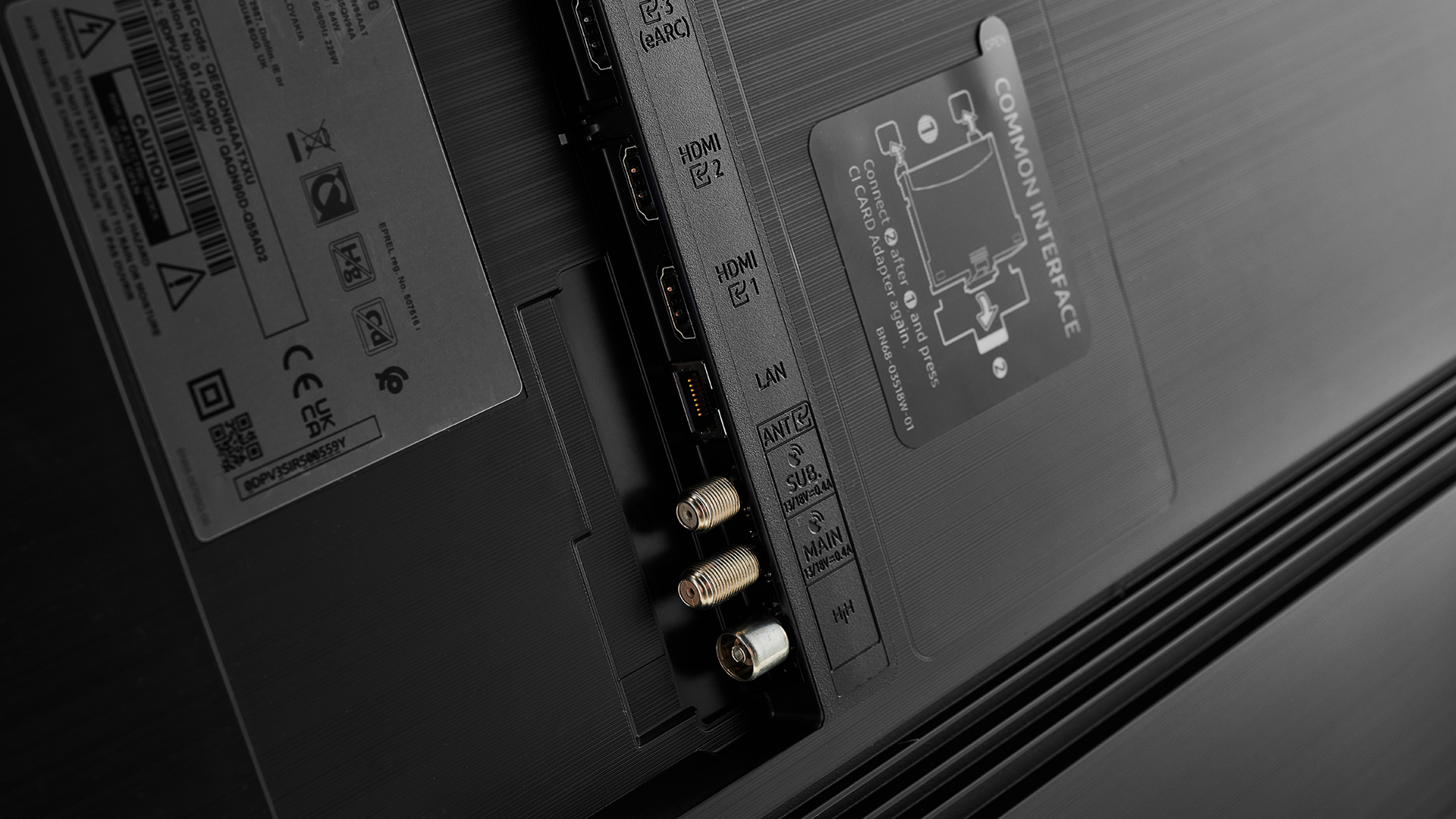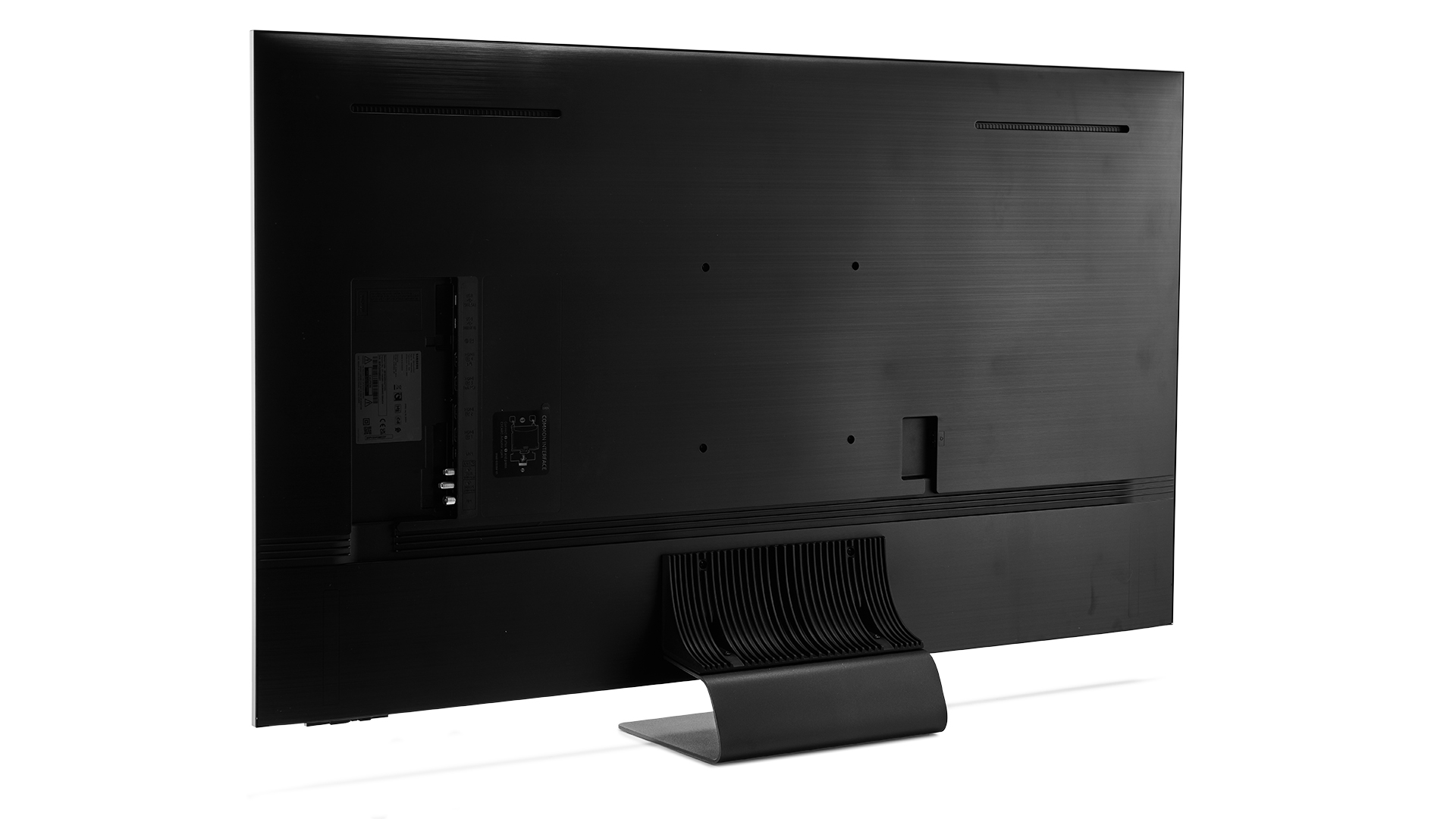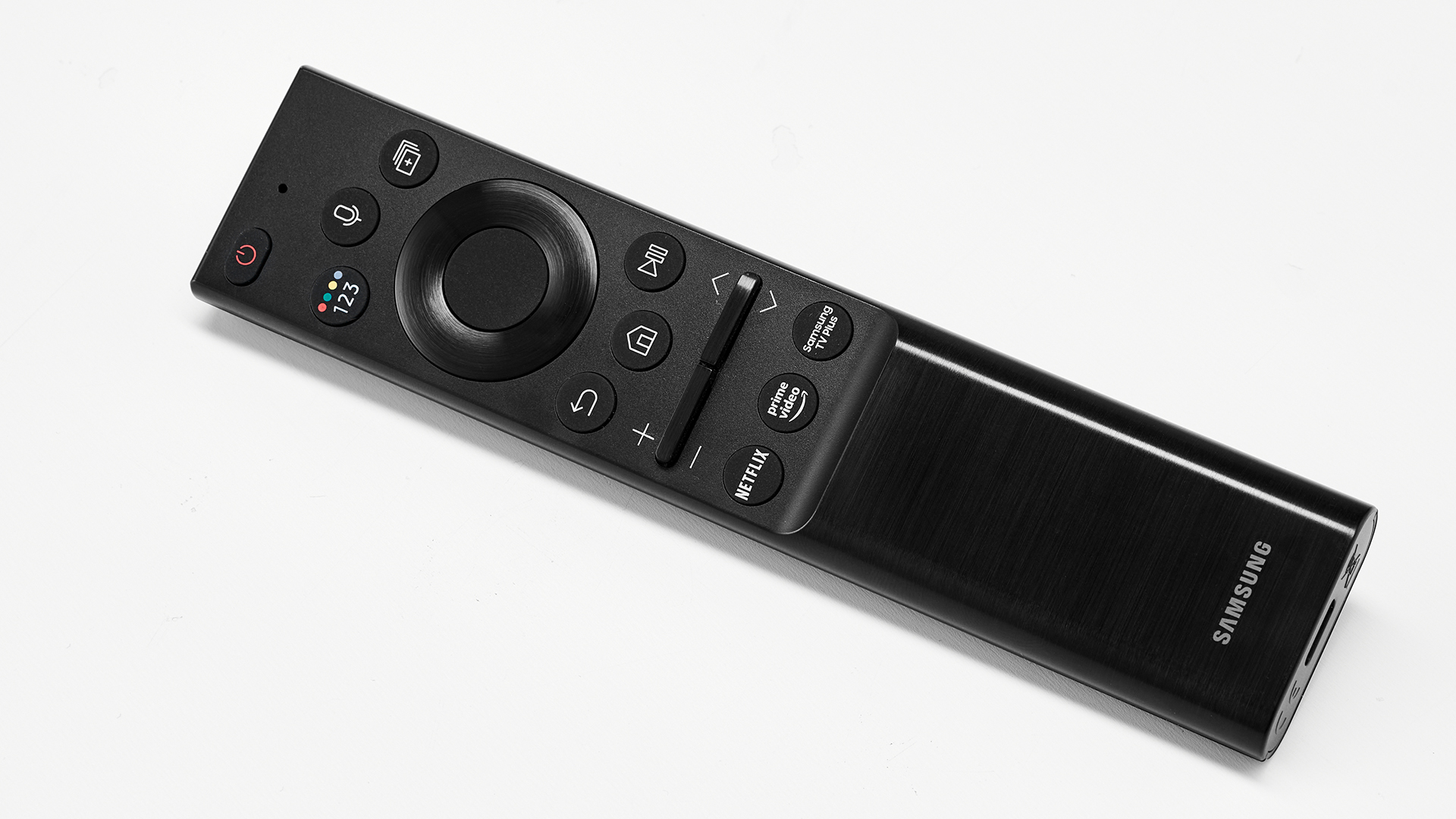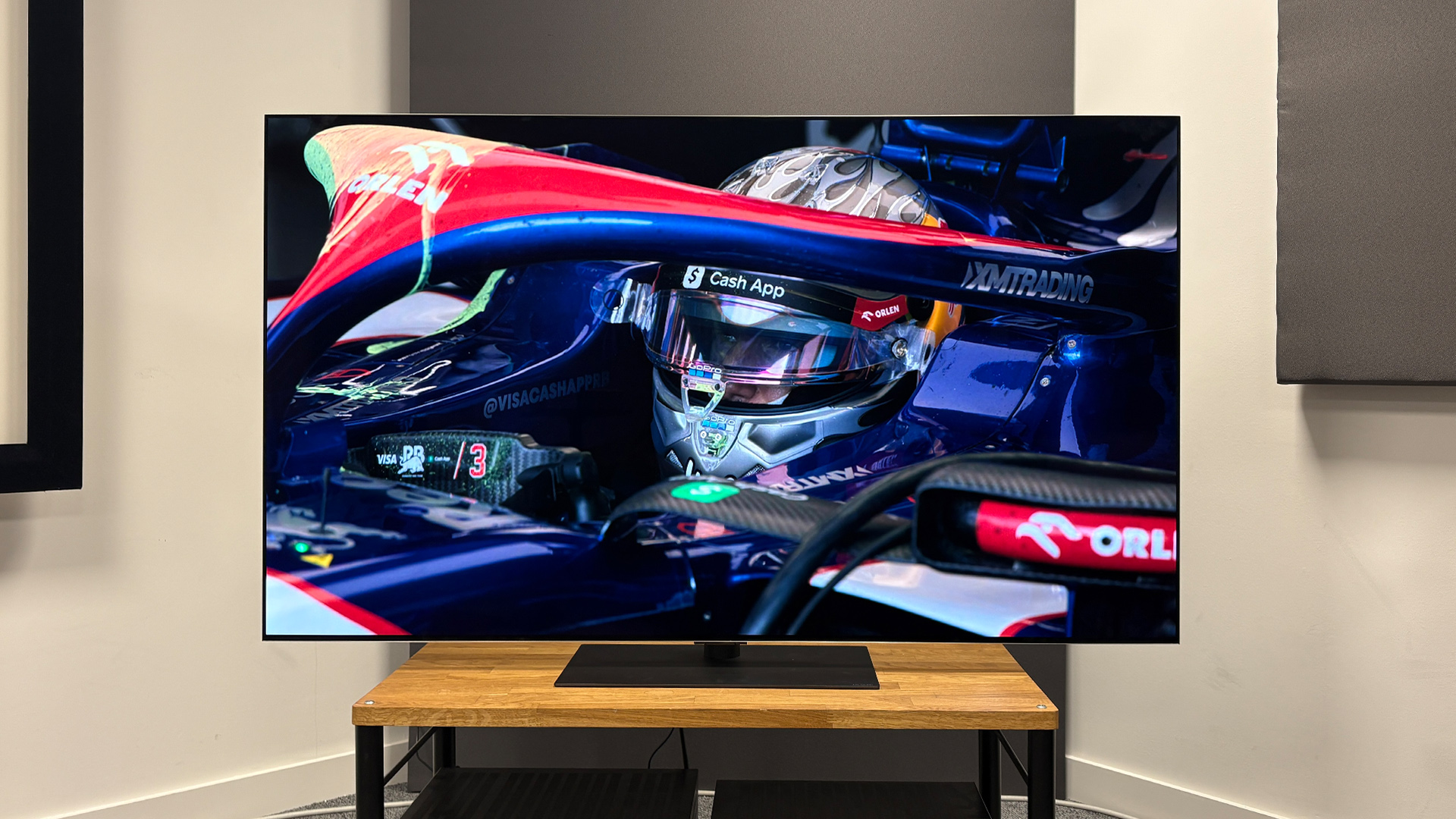What Hi-Fi? Verdict
This is a powerful TV with an exciting picture – definitely one for your shortlist
Pros
- +
Terrifically bright, punchy picture
- +
Superb detail and sharpness
- +
Excellent TV operating system
Cons
- -
Light control not perfect
- -
Good, not great, sound
- -
No Dolby Vision
Why you can trust What Hi-Fi?
Samsung’s first flush of Neo QLED TVs has been nothing short of revolutionary to date. The extra-fine level of lighting control that mini LED brings has put LCD’s high peak brightness to sophisticated use. It’s added a care with contrast that’s led to a more nuanced on-screen image, with a more solid, three-dimensional depth than ever before. We’ve every reason to expect the same from the QN94A.
If ‘QN94A’ seems a bit of an odd number, that’s to indicate that there’s only a small difference between it and Samsung’s top 4K TV for the year, the QN95A. The QN94A TV is identical apart from missing out on the One Connect box – a discrete box that houses all of the QN95A's connections, including power.
There’s no doubt that the One Connect is an elegant solution to your cabling needs but, if you’re not bothered about hiding away all your wires, and are content with just one HDMI 2.1-certified socket, then the QN94 could be a handy way of saving a bit of money.
Price

The Samsung QE55QN94A is £1499. That’s £100 cheaper than the 55-inch QN95A, which comes with the One Connect box and three more HDMI 2.1-certified HDMI ports. The Samsung QE55QN94A still has four HDMI ports but only one of these is HDMI 2.1-enabled. The two TVs are otherwise identical.
Build

Even without the One Connect, the Samsung QE55QN94A is a very tidy machine indeed. Unlike most OLEDs, which feature plenty of lumps and bumps on the rear, Samsung designs its premium TVs with an attractively uniform, single-thickness profile of just over an inch. They may not be wafer thin but they look well finished and smart.
The front face has a minimal 0.1-inch bezel – giving the picture an edge-to-edge feel – and the whole panel feels nice and secure on the central C-shaped metal plinth. It not only looks tasteful but also makes positioning on narrow surfaces far easier than it is for TVs with widely spread feet. There's plenty of room for a soundbar too.
Around the back you’ll find all the sockets you need. There are four HDMIs, including one that is 2.1-certified with ALLM, VRR and 4K 120fps gaming abilities all featuring. There's also an optical audio-out port and two USBs to choose from. Bluetooth is onboard for wireless headphone use. If you need more HDMI 2.1s, then it’s the QN95A that you should buy instead.

Screen type QLED with Mini LED backlight
Resolution 4K
Operating system Tizen
HDR formats supported HDR10, HDR10+, HLG
HDMI x4 (HDMI 2.1 x1)
4K@120Hz Yes
VRR Yes
ALLM Yes
ARC/eARC eARC
Optical out Yes
Weight 21.9kg (with stand)
Dimensions (HWD) 77 x 123 x 24cm
Fortunately, the One Connect is the only luxury that Samsung has nixed from this TV. There are still two remote controls in the box – the standard Samsung remote and the excellent Samsung One Remote, which comes in black metal for this season and doesn't require batteries, thanks to a solar panel on the rear that does a very tidy job of renewable recharging. Even in our windowless AV test room, the house lights are enough to keep us from needing to juice up manually (which is done via USB-C).
The insides of a Neo QLED are arguably the highlight. Mini LEDs are one-fortieth the size of their traditional counterparts and quite astonishing to behold, looking like little more than glitter when held in your hand. In the backlight of the QN94A they number in the thousands, arranged in approximately 800 individually dimmable zones, compared to the 120 or so in previous Samsung QLED TVs. The light shines through a 'micro layer' that guides it through the quantum dots which then provide the colour.
Samsung’s Neo Quantum Processor 4K directs the traffic using its Ultra Precision Light Driving technology. It controls dimming more carefully than before and reroutes power away from the dark sections of the panel to boost the brightest areas as required by each frame. There’s also the promise of ‘deep learning’ to improve contrast.
Features

Samsung’s Tizen OS continues to be the best TV interface this year and we don’t see that changing any time soon. While Sony and LG suffer the temporary hiccups of missing UK catch-up services and, in the case of the former, an HDMI update for VRR that never seems to come, Samsung and Tizen are as solid, fully-featured, graphically appealing and easy to use as ever. We hope that whoever came up with it has a suitably large office with a top-floor panoramic view. They deserve it.
It’s as nigh-on perfect for app support as you’re going to find. All that’s missing is Sky Store, BT TV, Twitch, VLC and TuneIn, but these aren’t serious concerns. As far as major streaming services and catch-up platforms go, it’s a full house – and in 4K HDR wherever that’s possible.
The increasingly serious drawback for Samsung is that it continues to shun Dolby Vision in favour of the company’s own HDR10+ dynamic HDR standard. While HDR10+ content is slowly spreading across YouTube, Amazon Video and on a few Blu-ray discs, Dolby Vision is fast approaching ubiquity and has a stronger claim to delivering on creative intent. Crunch time could be approaching for Samsung to fall in line, but it’s not come early enough for the QN94A.
There’s little to want in the way of smart control and connectivity compared to other manufacturers, though. Users get the choice of Bixby, Alexa or Google as their voice assistant on set-up and there are plenty of great utility apps, including Google Duo (for video calling) and Samsung Health, which boasts 3000-plus hours of health and mindfulness content.
We particularly like Samsung’s Multi View, which allows you to splitscreen your Tizen TV with an HDMI source in one half and YouTube in the other. Even on a 55-inch screen it’s well worth using. We look forward to when Samsung adds compatibility for other apps and services.
Picture

We head straight for a modern day big hitter with Christopher Nolan’s Tenet on 4K Blu-ray, and all fears of the mind-twisting plot to come are replaced by the wow factor produced by the way this TV handles the action.
The first chapter’s police raid on the National Opera House in Kiev is a masterclass of HDR performance. This TV is so bright compared to OLEDs, with the Mini LED technology allowing for such careful pinpoint control of that luminance, that it’s hard to draw our eyes away from the action even for a second.
It doesn’t quite go as black as the midnight of an OLED – the police uniforms and the deepest shadows come off ever so slightly tinged towards a dark navy blue – but the extra brightness makes for a high contrast feel and super punchy and dynamic presentation. The difference between the curtains, the seats and the black clothing of the players in the orchestra are kept wonderfully dark while highlights such as the bulbs of the strip lighting and the faces of the audience can still be bright and distinct.
Detail is razor sharp when we get the close-up of John David Washington’s face in the ensuing torture scene. Every pit and pore is revealed and he’ll be glad the makeup department did such a good job should he ever watch the film back on a QN94A.
The North Sea shots of the ferry taking Washington back to land from the off-shore turbine site are a stunning example of the very best of what this TV can do. There are good cloud details in the murky overcast sky, the water is a beautiful deep blue, the foaming waves are wonderful accents of brightness and the lines and details of the grey vessel offer brilliant definition. It’s inviting, immersive and makes you want to go out and buy a stack of 4K Blu-rays to find other great moments like this.

It’s not all easy money for this TV, though. Boost this set to its contrasty best and you’ll occasionally notice that there’s a little dark detail that’s lost. There is also the odd moment where the TV’s brightness gets a touch out of control and details can sometimes be either overblown or underplayed. It’s possible to tone both of these down but to take them away would also hobble the QN94A’s very best characteristics.
As usual with Samsung’s QLEDs, there’s not a huge amount to do with the contrast, brightness and colour sliders to get the best out of this TV. Instead, the Contrast Enhancer, Shadow Detail and Local Dimming filters are the battleground. You can go for a more natural look by keeping the first and last of these in the Low or Off positions but it feels a bit like keeping a sports car out of top gear. This TV wants to run with its turbos on.
You’ll pick up warning messages about power consumption when you switch the Local Dimming up to High but push through this and make sure you’ve got the brightness optimiser and other shackles switched off while you’re at it. The trade-off is that you’ll need to go easy on the Contrast Enhancer and add a smidge of Shadow Detail to make sure that you can still see the differences in tone when things get dark.
The result is a 4K HDR picture that we find a little more exciting than the similarly priced Sony A80J during bright scenes. Sony’s OLED is only a hair behind on dark detail and does a little bit better at shading some scenes, but there’s still enough skill in the QN94A to give us a very three-dimensional feel as our hero climbs up the inside of the tall turbine tower.
Performance is equally competitive when upscaling from 1080p. The sweeps over the Canary Islands in Fast & Furious 6 in HD on Blu-ray show off the Samsung’s strength of colour. The grasses, the sea, the reds and purples of the blooming flowers all make you want to retire to some far-away paradise. The Sony is probably a tiny bit richer at that red end of the spectrum and warmer on the yellows, but Samsung wins on the cooler shades.
You’ll need a lighter touch on the contrast and dimming filters at lower resolutions. The picture will come off too pushed and too coarse otherwise. All the same, there's still extra peak brightness in the tank, and the QN94A deploys it as needed.
Watch the scene in the garage in London and you’ll notice some beautiful reflections in the windscreens of the highly polished sports cars, which shine with a greater lustre than OLEDs can manage. Of course the trade-off is that this LCD-based TV can’t quite match the OLED blacks when it comes to the night-time race through the tunnels, but no TV has it all – at least not yet.
Even at standard def, this TV holds onto its powers remarkably well. Troy on DVD comes out without noise and with far more complexity than it has any right to when upscaled to this level. Colours still maintain accuracy, whether skin tones, the blue of the sky or with the yellows, browns and reds of the earth. The picture even nearly manages to look detailed.
Sound

Sound has always felt secondary for Samsung when it comes to its TVs, and that’s quite understandable. Samsung will point you towards its Q series range of soundbars and we’d certainly encourage you to seek out an external audio solution for your AV room too. You’ll benefit from a sense of scale that no TV speaker system can match.
That said, Sony, Panasonic and Philips have all upped their game with forward-facing sound solutions that tend to offer better precision and good sound projection. While Samsung hasn’t gone down that route for the QN94A, it does seem to have responded to the challenge. The audio from this TV is a significant improvement on previous seasons.
Our time with Tenet has more clarity than Samsungs of old, which leaned a little too far towards attempts to impress with bass. A lot of that old muddiness has been traded for top-end skill and the result is a more balanced audio presentation. Ludwig Göransson’s score for Tenet still pumps the rhythm of the scene but without swallowing up the vocals or effects. We can hear the lines of ‘The Protagonist’ clearly enough, even in his gas mask, and there’s enough precision to pick up the flight of bullets and shards of glass as and when they find their mark.
There are some interesting sound options to choose from. Alongside Samsung’s usual Standard and Amplify settings (Standard is the better here) is Samsung’s Intelligent Mode. Within that menu is Adaptive Sound+, which analyses your space in real time to provide a better audio delivery. For our money, it’s worth using but that might depend on the acoustics of your room. In our AV facility it adds a touch more spread of sound and a shade more dynamism.
The QN94A features Samsung’s OTS+ (Object Tracking Sound) system, which consists of two physical speakers at the bottom of the set, two at the top of the set, and two side-firers. All of these are hidden within the frame.
There’s not a huge amount of movement of effects across the soundstage but the audio does push out nicely towards our sitting position. It would be nice to get a little more sonic distance side to side as the siren of a police car drives by in the background.
What mostly separates the QN94A from the top performers for TV sound is a slight dip in the midrange. Certain drum beats in the score and moments when doors are smashed open in the Opera House feel a little short on impact. Voices could also be a touch richer.
As we say, though, we’d certainly take this approach to sound over what we’ve had from Samsung in previous years, but the audio is still behind that of the very best TVs in the class. An external speaker system is a must in order to do justice to the picture performance.
Verdict
The difference in price between the QN94A and QN95A isn’t huge, but if you’re not interested in the One Connect box and the extra HDMI sockets for gaming, then it’s worth saving some money on the former. Picture quality is compelling and the sound isn’t bad at all. An OLED might look better in some scenes but there’s something quite addictive about the brightness of this set. Its super-contrasty and punchy HDR delivery is ever so more-ish.
There’s still no Dolby Vision support but you’ll be getting so much from HDR10 alone that it will hardly be on your mind. This is a great TV and a terrific buy at this price.
SCORES
- Picture 5
- Features 5
- Sound 4
MORE:
Want to find the best TV for the best price? Check out these deals
Here's our round up of the best Samsung TVs 2021
Read our review of the Sony XR-55A80J
Read our review of the LG OLED65C1
Dan is a staff writer at What Hi-Fi? and his job is with product reviews as well as news, feature and advice articles too. He works across both the hi-fi and AV parts of the site and magazine and has a particular interest in home cinema. Dan joined What Hi-Fi? in 2019 and has worked in tech journalism for over a decade, writing for Tech Digest, Pocket-lint, MSN Tech and Wareable as well as freelancing for T3, Metro and the Independent. Dan has a keen interest in playing and watching football. He has also written about it for the Observer and FourFourTwo and ghost authored John Toshack's autobiography, Toshack's Way.

